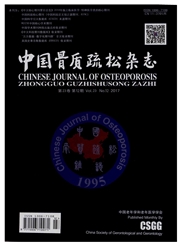

 中文摘要:
中文摘要:
目的初步探讨绝经后妇女骨密度与血红蛋白、血小板的相关性。方法随机选择319例福州常住汉族绝经后妇女,分为骨质疏松组147例,非骨质疏松组172例,双能X线骨密度仪测定腰椎、股骨颈、大转子和Ward’s区骨密度,SPSS18.0统计软件分析血红蛋白、血小板与不同部位骨密度的关系。结果 (1)与非骨质疏松组相比,骨质疏松组患者的血红蛋白含量更高(z=-3.099,P=0.002),血小板计数更多(z=-3.436,P=0.001)。(2)校正年龄、体重指数和绝经年限后,血小板与腰椎、大转子骨密度呈负相关(r1=-0.189,P1=0.001;r2=-0.146,P2=0.009);血红蛋白与腰椎、大转子骨密度也呈负相关(r1=-0.133,P1=0.018;r2=-0.200,P2=0.000)。(3)多元逐步回归分析显示,血红蛋白与大转子骨密度呈负相关(β=-0.183,P=0.000);血小板与腰椎骨密度呈负相关(β=-0.182,P=0.001)。结论绝经后妇女低骨量的发生与血红蛋白、血小板均存在负相关,鉴于与当前部分结果并不一致,故仍需进一步深入探究。
 英文摘要:
英文摘要:
Objective To investigate the relationship between bone mineral density( BMD),hemoglobin( HGB),and platelet( PLT) in postmenopausal women. Methods A total of 319 postmenopausal Han women,who lived in Fuzhou,were randomly selected and divided into osteoporosis group( OP group,147 cases) and non-osteoporosis group( NOP group,172 cases). BMD of the lumbar vertebrae,the femoral neck,the greater trochanter,and the Ward’s area was detected using dual energy X-ray absorptiometry. The correlation between BMD of different parts,HGB,and PLT was analyzed using a SPSS 18. 0 statistical software. Results Compared with those in the NOP group,the hemoglobin level( z =- 3. 099,P = 3. 099) and platelet count( z=- 3. 436,P = 0. 001) in OP group were higher. After adjusting for age,body mass index( BMI),and duration of menopause,PLT was negatively correlated with BMD of the lumbar vertebrae and the greater trochanter( r1=- 0. 189,P1= 0. 001; r2=-0. 146,P2= 0. 009). HGB was also negatively correlated with BMD of the lumbar vertebrae and the greater trochanter( r1=-0. 133,P1= 0. 018; r2=- 0. 200,P2= 0. 000). Multiple stepwise regression analysis showed that HGB was negatively correlated with BMD of the greater trochanter( β =- 0. 183,P = 0. 000). PLT was negatively correlated with BMD of the lumbar vertebrae( β =-0.182,P =0.001). Conclusion The occurrence of low bone mass in postmenopausal women is negatively correlated with HGB and PLT. This result is not consistent with several current results,therefore,further study is needed.
 同期刊论文项目
同期刊论文项目
 同项目期刊论文
同项目期刊论文
 期刊信息
期刊信息
